In a short couple of years, Kahoot has become a pretty commonplace activity in many classrooms. Kahoots can be used to preview & teach material, to practice skills, to solidify vocabulary, … you name it! I think you’d be hard-pressed to find a teacher that hasn’t at least heard of Kahoot, let alone played it.Want to learn more about Kahoot? Check out my introductory blog post here.
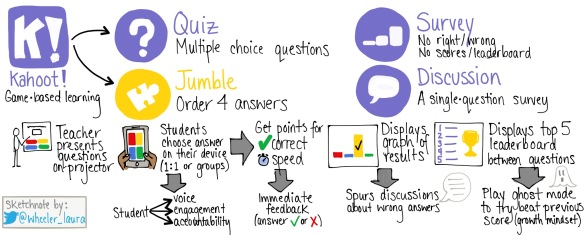
I’ve been working with my 2 student teachers this semester and as I’ve been sharing with them my ideas of the pedagogy of Kahoot, I thought it might be worth sharing here also.
My most common way to play Kahoot is to use a bank I made of almost 100 questions covering the most basic skill sets as laid out by the curriculum for each course I teach. There are some options that I like to pick to make the game run well for us:
– answer streaks get displayed & rewarded
– name generator (so I don’t have to worry that the names they pick in another language might be inappropriate)
– podium allows us to see the top 3 players at the end … I give out a sticker to each of the top 3 (yes, grade 10 students still love a good sticker!)
– randomize the questions & the answers (we don’t play the whole bank of 100 questions at once)
– display game pin throughout so that students arriving late can join easily & if the wifi kicks someone off, they can rejoin (albeit losing their points).
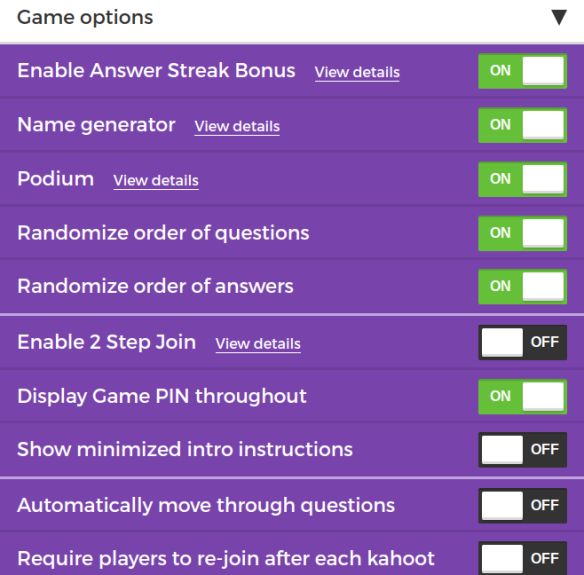
The most important thing, since we use this as a question bank, is that I randomize the order of questions & answers both. So of my bank of almost 100 questions we might play 10 or so questions at a time. Since the questions involve some calculating, it can take us up to a half hour to play through those 10 or more questions.
As my students join the session, I remind them to have paper, pencil, calculator & course pack out on their desk: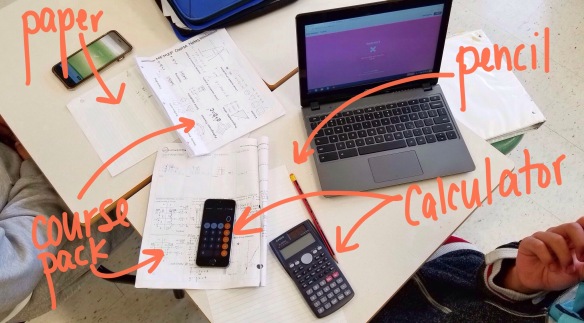
I do this to stress that they should solving & calculating; not guessing.
We play through the questions, they are timed according to the difficulty of the question; the harder or longer the problem, the more time they get to find an answer (up to 2 minutes max). After each question, Kahoot displays a graph of how many students picked each of the answers: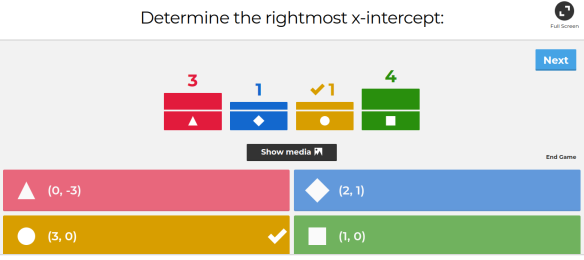
When most students have the right answer, we simply move on to the next question. When roughly half or 2/3 of them get it right I will do a little direct teaching up on the board, asking students to explain to me the justification behind the correct answer. When few students get the correct answer (like in the graph above) I will send them to their boards to solve it in small groups (in my class we sit in daily random groups of 3; VRG & do problem solving on vertical chalk- & white-boards; VNPS ). Even though my students are allowed to talk & help each other during Kahoots, something about getting out of your seat, going to the VNPS & working with your group members, seems to get the juices flowing & it’s usually not long before every group has the correct solution shown on their board (without any direct teaching on the topic from me).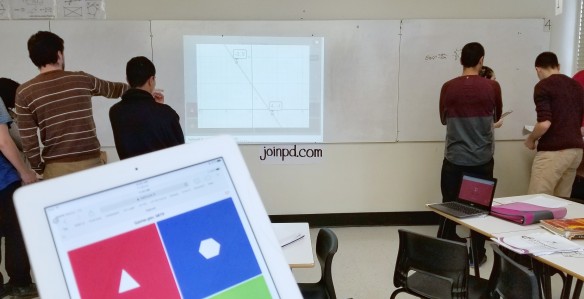
We can play Kahoot this way, with this bank of problems, because I spiral/cycle my courses – not teaching unit by unit:
This means teaching every expectation in the curriculum over the first few weeks, albeit in an introductory fashion. Then we cycle through all the material for a 2nd time, delving deeper. And then again a 3rd or maybe 4th time through depending on time. Mary Bourassa has a good explanation here of spiralling.
At the beginning of the year, I use the “skip” button in the top right corner of the game to skip questions we haven’t covered yet. At this point in the semester (mid-way through 4 of the 5 months) we’ve covered all the skills needed in the course because of spiralling. Now we’re left to work on more complicated application problems. So when we played Kahoot today we did not have to skip any of the questions in our game.
Here are my banks if you want to use them:
Grade 9 (MPM1D & MFM1P combined):
https://play.kahoot.it/#/k/cbcf329d-7e08-4e65-967f-7f559d064d2c
MPM2D, grade 10 academic:
https://play.kahoot.it/#/k/0fbaf64c-1af9-4007-8cc1-d4fdc45236df
MFM2P, grade 10 applied:
https://play.kahoot.it/#/k/e3dfb0a4-dd78-4928-aa3f-e578eae07850
So that’s how Kahoot works best for me & my students. How do you use Kahoot? Share your thoughts in the comments below.
– Laura Wheeler (Teacher @ Ridgemont High School, OCDSB; Ottawa, ON)

Pingback: Kahoot: game-based learning | Wheeler's thoughts on teaching
Pingback: This Week in Ontario Edublogs – doug — off the record
Excellent blog. I’ve used Kahoot a fair bit, but not as effectively or efficiently as this. I will literally be “upping my game” after reading this. Thanks for the info!
Pingback: This Week in Ontario Edublogs | voicEd.ca
It’s awesome game quiz.I’ll keep it for playing with my friend 🙂
Pingback: Play Kahoot! and Downplay the Time Factor | MathyCathy's Blog – Mrs. Cathy Yenca
Kahoot is a game-based learning platform from Norway used as an educational tool. It has learning games, which are also called “Kahoot.”